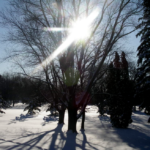 Through a dark time tunnel, morning and evening like midnight, I treasure this season of inwardness, enfolded in soft wraps against the chill. Warmth and stillness billow into the forefront of luxuries.
Through a dark time tunnel, morning and evening like midnight, I treasure this season of inwardness, enfolded in soft wraps against the chill. Warmth and stillness billow into the forefront of luxuries.
What I can share here are ways to feel the warmth and stillness any time, ways that have emerged from a convergence of several different practices: first, a contemplative question of “Where am I?” (rather than the standard “Who am I?”), combined with some new dream-expansion processes, followed by a perceptual shift that considers all states of being as forms of dreaming – waking, dreaming, meditating, and deep-sleeping. And finally, I add the writing technique of elaborating the ground into which the reader is invited, a sensory enhancement that creates a coherence between felt-sense and intellectual expression. Here are the pieces that have all come together, approaching this moment of Solstice (December 21, 2:23 p.m. Pacific):
“Where am I?” opens the gates: the single unifying fact of Winter Solstice – the moment of greatest relative planetary tilt into the dark in the north, the light in the south – opens a window into humanity’s shared existence, our spinning around together in the void, never to return to this spot in the cosmos. In the next moment, we start measuring a new trip around our home star.
For that new beginning, I offer the next steps for the dream processes:
* Beyond a long immersion in “Where am I?”, coming to peace within it, fully feeling the capacity to witness all phenomena, is “How did I get here?” This contemplation can calm, ground, and enlighten, can let shards of the past dissolve and reveal core energy as clearer, more present and available for new dreams. It also helps reorient awareness in the physical self, especially when sensations of dislocation are overwhelming – situationally, emotionally, or intellectually.
* Beyond the idea of all states of being as forms of dreaming is the practice of asking, in full waking state (walking in sunlight, performing tasks, interacting with other people, reading or writing, listening to or playing music, looking into computer screens): “Am I dreaming?” This moves a familiar notion into lived experience – Taoist Zhuangzi’s insight upon waking: “Now I do not know whether I was then a man dreaming I was a butterfly, or whether I am now a butterfly, dreaming I am a man.” With practice, this inquiry fluffs up the imagination, flexes and enriches it, revealing the seamlessness of night and day. (This can be disorienting. Use cautiously at first.)
* Beyond description of elements in a remembered night-time dream, or a waking-state vision, is a shift in perception, so that each element is experienced as having its own life (“The plant expressed its displeasure at being placed on the landing by browning its leaves and dropping them all over the stairs”). This technique is much more enlivening than cartoon images of sentient teapots and candles; it can generate awareness of being the living environment of the other elements in the dream, a sensation that energizes every experience in the waking state.
Feeling these dreamstates can illuminate the process of writing, of creating a world into which to invite a reader or a film watcher. Or, when “writing” a life, creating a world into which to invite others, for whom you are part of their environment. Being an active participant/creator in the waking or sleeping dream is also part of “lucid dreaming” practice, simply and enthusiastically described in a “field guide” that even includes practices for rewriting nightmares.
May your midwinter dreams be beautiful – whether they arise first in their shining form or in a spooky way that highlights their benevolent opposites and inspires a transformation, first moving through the dreamtime, waking or sleeping, then flowing into the material plane.
Photo credit: paleangel7 via stockxchange